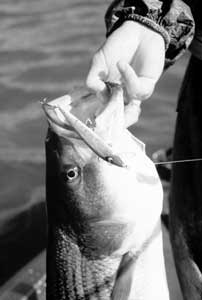
Bass fishermen constantly refer to jerkbaits as among the most productive lures in their tackle boxes in late February and early March.Those comments came as a surprise to me, which probably explains why I catch fewer fish than my buddies. I always considered jerkbaits to be dynamite fish-catchers when bass were in a postspawn mood. And that’s when I almost exclusively used them.
It took three of the state’s best bass fishermen to convince me that in late February and early March bass are really much better times to use the long, skinny minnow baits — probably the best season of the year for somebody to snap a Husky Jerk, a Long A, a Pointer or a Rogue down in front of a big bass.
“A jerkbait works better when the water’s cold — 47 to 54 degrees — that’s the best time to use one, especially at Shearon Harris and Jordan,” said Jeffrey Thomas of Broadway, an FLW Tour pro who also guides on those two lakes. “I think those big female bass get out and suspend on the points before they really move up. When they really move in, they’ll relate more to cover, things like laydowns, and you catch ’em on spinnerbaits or jigs.”
Thomas believes big female bass want to eat as soon as they make their first move towards the shallows, but they just aren’t able to because their metabolism isn’t up to speed. So they’re stuck feeding on slow-moving prey until the water warms up.
“They’ll hit a jerkbait when they won’t hit a lot of other baits,” he said. “The first couple of weeks when they first start to move up is the time to use a jerkbait.”
Retired guide Ed Hancock of Wake Forest, who took parties to Falls of Neuse, Jordan and Harris for years, agrees one of the reasons a jerkbait is a great late-winter, early spring bait is because bass are feeding on shad, and they’ll hit any bait that stand a decent chance of catching without having to chase.
“My theory is that, in the very early season, bass are feeding on shad, when they see a jerkbait, they have time to go get it,” he said. “The water’s pretty cool, and if a Rat-L-Trap moves past at lightning speed, they can’t run it down and catch it.”
What makes a jerkbait a great bait when bass are lethargic — remember those postspawn bass? — is the proper way to fish a jerkbait involves long periods when the bait isn’t moving, and you aren’t moving the bait.
Joel Richardson of Kernersville, another FLW Tour pro who guides at Buggs Island, Gaston and the Raleigh-Durham area lakes, said one key is the bait naturally operates at the kinds of depths where big fish feed during late February and early March.
“I’ve caught ’em 5- or 6-feet deep over 25 or 30 feet of water, and I’ve caught ’em 4- or 5-feet deep over 8 to 12 feet of water,” Richardson said. “Like an old Bomber Speed Shad, a jerkbait will catch suspended fish that are sitting out suspended over points or along bluff banks.
“That’s the No. 1 reason, because fish are suspended in the warmer, upper layer of water below the surface.”
Richardson fishes the bait two ways: cranking it down to the proper depth and retrieving it with a jerk-jerk-pause cadence, or moving it by sweeping his rod tip 3 or 4 feet at a time, then reeling in the slack.
“That makes it look like the bait is swimming 4 or 5 feet, then pausing for two or three seconds,” he said. “I’ll catch ’em fishing it both ways, but sweeping your rod tip really works good in cold water.”
Thomas said the speed of the retrieve is paramount to fishing success with a jerkbait.
“I fish it real slow,” said Thomas, who normally fishes a Berkley Frenzy jerkbait. “I reel it down as deep as it will go, then I jerk it three times — jerk, jerk, jerk — and let it sit. It’s almost painstaking. It just sits there and suspends.”
Hancock said he often lets the bait suspend for 15 seconds of more after a series of jerks, and he’s convinced it takes that long sometimes to draw a strike. At the end of that long pause, he said, “A lot of the time that’s when they come and get it.”
That’s one reason when he was guiding regularly, soldering tape was a big part of his tackle box.
“I’d wrap it around the base of the hooks on a Rogue or a Team Daiwa jerkbait, and I’d work the bait down to the depth it would run, the jerk it a couple of times and stop, and it would really stop and suspend when you quit jerking it,” he said.
Thomas said he likes to get his baits down about 5 feet. A jerkbait can be deadly near rip-rap, especially at Jordan Lake, a secret he wasn’t terribly thrilled to share.
One thing he stressed was anglers need to have clear water for a jerkbait to be as productive as possible because the strike from a bass is almost always a visual one.
“You can’t use it in dirty water, so that makes it pretty much a main-lake type deal,” he said.
Richardson agreed fishing a jerkbait in dirty water is pretty useless. In fact, he goes looking for the clearest water he can find before he makes his first cast with a Smithwick Rogue, his jerkbait of choice.
“I won’t throw it if the water’s not clear,” he said. “I always look for the clearest water in the whole lake to use it.”




Be the first to comment